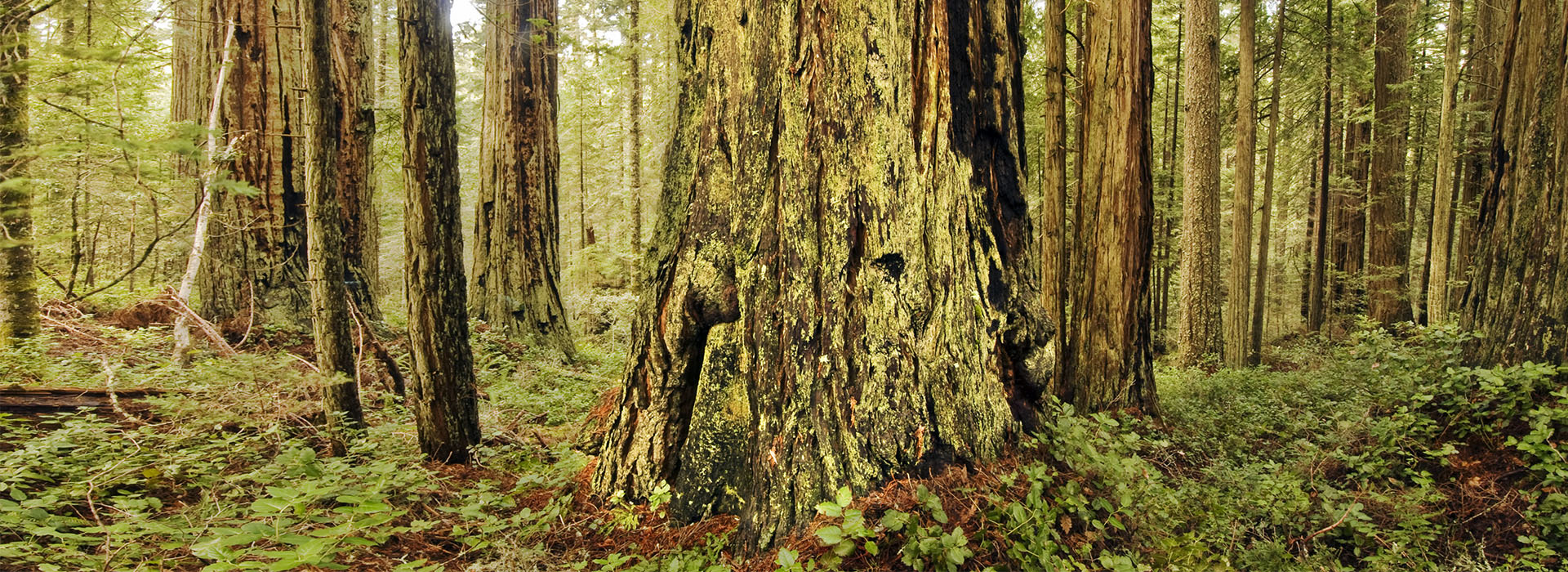
Old Growth
Large, old trees on the landscape are a key habitat element for terrestrial wildlife and plant species. Both MRC and HRC protect all trees meeting our old growth definition either as individual trees or as a stand of trees. To better manage our forestlands, we have divided old growth stands into two types (as defined by the Forest Stewardship Council): (1) Type I stands are unharvested old growth that are permanently protected from any harvest, and (2) Type II stands are previously harvested but retain significant old growth characteristics. Harvest of Type II stands is allowed only if the harvest will retain existing old growth trees and enhance the old growth characteristics of the stand. MRC has identified approximately 105 acres of Type I (unharvested) old growth stands while the HRC staff is currently working through an assessment identifying Type I stands on the landscape.
The remaining previously logged second-growth forests on MRC and HRC lands contain scattered old growth trees in low densities on MRC lands and greater densities on HRC land. These old trees are being preserved based on the protection policy below that defines old trees based on age, size, function and characteristics specific to particular species. As far as we know, MRC and HRC are the only large industrial forestland owners to have such a comprehensive old growth protection policy.
Individual trees preserved from harvesting include:
- Any redwood tree, = 48” diameter at breast height (dbh), established prior to 1800
- Any Douglas-fir tree, = 36” dbh, established prior to 1800
- Any tree established prior to 1800 (conifer or hardwood), regardless of dbh, with a preponderance of species-specific old growth characteristics
- Any tree (conifer or hardwood) established prior to 1800 that cannot be replaced in size or ecological function within 80-130 years regardless of dbh or presence of old growth characteristics. Generally, this fourth trigger is applicable to areas of exceptionally low soil quality, such as pygmy forest, pygmy transition soil, serpentine soils, or rocky outcroppings.
Species Specific Old Growth Characteristics
Redwood:
- Trees generally in the upper 20% diameter class of the species on site
- Deeply fissured bark, fire resistant
- Flattened or irregular crowns, highly complex structure
- Large limbs, in excess of 6 inches in diameter
- Crown debris accumulations
- Platforms
- High presence of complex lichens or moss
- Cat-facing or basal burn cavities (goosepens)
Douglas-fir:
- Trees generally in the upper 20% of diameter class of the species on site
- Plate-like bark with deep fissures, thick and fire resistant
- High presence of lichens and moss, and where crown soils present, ferns
- Large lateral limbs in excess of 8 inches in diameter
- Flattened, irregular crowns with lower limbs with signs of decay and crown thinning
- Conks
- Partial sagging in tops
- Broken tops
- Crown debris accumulation
- Trees along the margins of vegetation types, which represent the pioneer tree individuals, which reoccupied the sites following disturbance. These normally will have limbs extending nearly to the ground and can be wind-shaped.
Hardwood (tanoak, live oak, black oak, madrone, laurel, chinquapin):
- Trees generally in the upper 20% diameter class for the species on site
- Flattened or irregular crowns, highly complex structure
- Multiple branching crowns with few large well-developed main limbs
- Large limbs in excess of 4 inches in diameter
- Crown debris accumulations
- Platforms
- Cavities, partial snag formation
- Crown die-back
- Cat-facing or basal burn cavities
Screen Trees
In addition to the policies above, we also retain screen trees around retained old growth trees where they exist. These trees provide additional cover and are usually immediately adjacent trees or trees which are close enough to influence the growth and form of the retained old growth tree. These may have intermingling crowns or crowns which if left to grow would eventually intermingle with the retained tree crown. For redwoods, trees with shared root systems (i.e. crown sprouts) indicate potential candidates for screen trees.
Special Circumstances
In rare instances, the cutting of an old growth tree is required for road construction, skyline corridors, or workplace safety considerations. Trees cut under these circumstances will be left in the forest to provide large wood on the forest floor. Old growth trees mistakenly cut due to misjudgment of age will also be left in the woods.